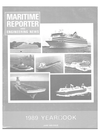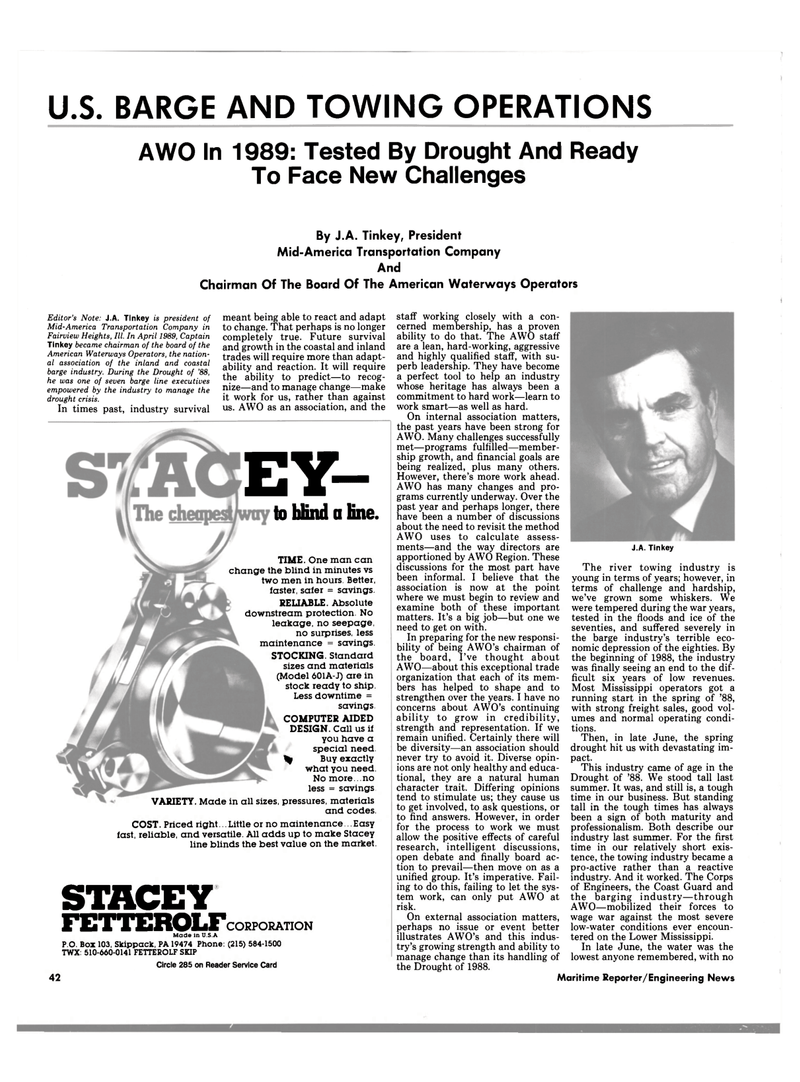
Page 38: of Maritime Reporter Magazine (June 1989)
Read this page in Pdf, Flash or Html5 edition of June 1989 Maritime Reporter Magazine
U.S. BARGE AND TOWING OPERATIONS
A WO In 1989: Tested By Drought And Ready
To Face New Challenges
By J.A. Tinkey, President
Mid-America Transportation Company
And
Chairman Of The Board Of The American Waterways Operators
Editor's Note: J.A. Tinkey is president of
Mid-America Transportation Company in
Fairview Heights, III. In April 1989, Captain
Tinkey became chairman of the board of the
American Waterways Operators, the nation- al association of the inland and coastal barge industry. During the Drought of '88, he was one of seven barge line executives empowered by the industry to manage the drought crisis.
In times past, industry survival meant being able to react and adapt to change. That perhaps is no longer completely true. Future survival and growth in the coastal and inland trades will require more than adapt- ability and reaction. It will require the ability to predict—to recog- nize—and to manage change—make it work for us, rather than against us. AWO as an association, and the
COST. Priced right. . . Little or no maintenance . . . Easy last, reliable, and versatile. All adds up to make Stacey line blinds the best value on the market.
STACEY FETTEROLF
Made In U S A
P.O. Box 103, Skippack, PA 19474 Phone: (215) 584-1500
TWX: 510-660-0141 FETTEROLF SKIP
Circle 285 on Reader Service Card
CORPORATION 42 staff working closely with a con- cerned membership, has a proven ability to do that. The AWO staff are a lean, hard-working, aggressive and highly qualified staff, with su- perb leadership. They have become a perfect tool to help an industry whose heritage has always been a commitment to hard work—learn to work smart—as well as hard.
On internal association matters, the past years have been strong for
AWO. Many challenges successfully met—programs fulfilled—member- ship growth, and financial goals are being realized, plus many others.
However, there's more work ahead.
AWO has many changes and pro- grams currently underway. Over the past year and perhaps longer, there have been a number of discussions about the need to revisit the method
AWO uses to calculate assess- ments—and the way directors are apportioned by AWO Region. These discussions for the most part have been informal. I believe that the association is now at the point where we must begin to review and examine both of these important matters. It's a big job—but one we need to get on with.
In preparing for the new responsi- bility of being AWO's chairman of the board, I've thought about
AWO—about this exceptional trade organization that each of its mem- bers has helped to shape and to strengthen over the years. I have no concerns about AWO's continuing ability to grow in credibility, strength and representation. If we remain unified. Certainly there will be diversity—an association should never try to avoid it. Diverse opin- ions are not only healthy and educa- tional, they are a natural human character trait. Differing opinions tend to stimulate us; they cause us to get involved, to ask questions, or to find answers. However, in order for the process to work we must allow the positive effects of careful research, intelligent discussions, open debate and finally board ac- tion to prevail—then move on as a unified group. It's imperative. Fail- ing to do this, failing to let the sys- tem work, can only put AWO at risk.
On external association matters, perhaps no issue or event better illustrates AWO's and this indus- try's growing strength and ability to manage change than its handling of the Drought of 1988.
J.A. Tinkey
The river towing industry is young in terms of years; however, in terms of challenge and hardship, we've grown some whiskers. We were tempered during the war years, tested in the floods and ice of the seventies, and suffered severely in the barge industry's terrible eco- nomic depression of the eighties. By the beginning of 1988, the industry was finally seeing an end to the dif- ficult six years of low revenues.
Most Mississippi operators got a running start in the spring of '88, with strong freight sales, good vol- umes and normal operating condi- tions.
Then, in late June, the spring drought hit us with devastating im- pact.
This industry came of age in the
Drought of '88. We stood tall last summer. It was, and still is, a tough time in our business. But standing tall in the tough times has always been a sign of both maturity and professionalism. Both describe our industry last summer. For the first time in our relatively short exis- tence, the towing industry became a pro-active rather than a reactive industry. And it worked. The Corps of Engineers, the Coast Guard and the barging industry—through
AWO—mobilized their forces to wage war against the most severe low-water conditions ever encoun- tered on the Lower Mississippi.
In late June, the water was the lowest anyone remembered, with no
Maritime Reporter/Engineering News
EY- to blind a line.
TIME. One man can change the blind in minutes vs two men in hours. Better, faster, safer = savings.
RELIABLE. Absolute downstream protection. No leakage, no seepage, no surprises, less maintenance = savings.
STOCKING. Standard sizes and materials (Model 601A-J) are in stock ready to ship.
Less downtime = savings.
COMPUTER AIDED
DESIGN. Call us if you have a special need. % Buy exactly what you need.
No more. . . no less = savings
VARIETY. Made in all sizes, pressures, materials and codes.

 37
37

 39
39
